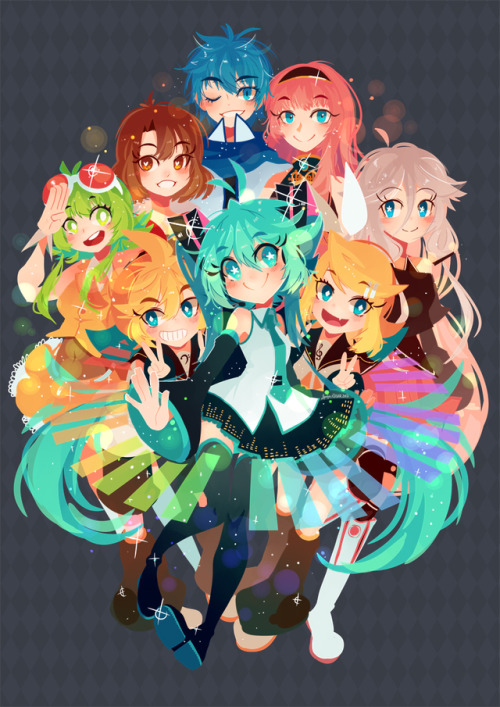Okey. There are quite a few videos in this post. You don’t have to watch them all!
BUT. I would like you to listen to this song before we begin. If you’re pressed
for time (or too lazy to listen to a 4 minute and 20 second song), skip to this
part here to only watch 30 seconds of it… 1:10-1:40
[ skip to 1:10 https://youtu.be/7t5JbAue6eY?t=71 ]
So much
emotion, yes?
Now let me
distract you with a question. You know that awful automated voice you hear when
you ask a translating app to say something? Uh huh. It sounds robotic and
creepy and choppy.
Yeah
whatever what’s the point? The lady you heard singing in the video? What if I
told you that her voice is a machine? That’s Vocaloid for you.
 |
| This is what the Vocaloid4 Interface looks like! |
But hold on.
Who exactly was that lady with green hair in the video? That’s Vocaloid GUMI,
and her voice provider is Megumi Nakajima. So the green haired lady is two
people? Well, no. The voice provider and the Vocaloid are two different things.
Nakajima is the voice provider. GUMI is what the vocal library is called. You
see, many of these vocal libraries have a character or mascot.
Are you
confused? Yeah, it took me awhile to understand too… Anyways, let’s take a look
at a group picture!
 |
| and no, it's not an anime |
It began
with only 5 vocal libraries and two languages (Japanese, English) when it was
first released in 2004. Now, Vocaloid has expanded and grown like you’ve never
believed. There are now at least 80 voice libraries and more languages (Korean,
Spanish, Chinese). In addition, the Vocaloid community has produced their own
holographic concerts that go on tour abroad, has sold merchandise like original
albums and figurines, and they’ve inspired this shareware program called UTAU
where you can make your own singing voice synthesizer for free! And there are covers
too. There are so many song covers.
Original Song (human & Vocaloid duet): Porter
Robinson – Sad Machine Lyric Video
(I'm having trouble embedding this video forgive me)
(I'm having trouble embedding this video forgive me)
Concert Video: [Official] NicoNico Music Party 2015
VOCALOID Live
(lol don’t watch the whole
thing it’s 40 minutes just do like 5:20-6:18)
Cover: [Kagamine Rin V4 English] Ariana Grande – Focus
– Vocaloid Cover by Jirai
Time to zoom
in! That first song you just listened to, “Circles,” was composed by
YusukeKira. He didn’t do all of the work alone though. Under the description,
the credits are as follows:
"Music: YusukeKira & chilichizu
Arrange/Lyrics: YusukeKira
"PV/Animation: Pancake
Illust: Ekkoberry
Encode: cheesum"
Like many
Vocaloid songs, the production of this song and music video was a collaborative
effort. Collaboration within the Vocaloid community is very common since one
person would tune the Vocaloid, another would make an instrumental track,
another would mix/master the music, and another would make the music video.
Even the music video itself would have its own team. As discussed in the Uzzi
& Spiro article, the Q-score, how closely knit collaborators are, can
affect how successful they’ll be. YusukeKira seems to have a medium Q-score,
which is typically more successful than higher or lower Q-scores. He collabs
closely with the people mentioned above and occasionally works with others in
the Vocaloid community (Rachie https://www.youtube.com/watch?v=sePdMu5fqNQ,
Crusher-P https://www.youtube.com/watch?v=8kjqsJy2kmU).
Funny
enough, the origin of Vocaloid began as “pure collaborative research, and they
did not think of selling it at that time.” Collaboration is what keeps a lot of
the Vocaloid community going and producing content.
Oh, are you
still here? Have a piano version of “Circles.” It’s really pretty. You won’t
regret listening to it!
Circles (Piano Ver.)
by YusukeKira feat. GUMI
Sources:
Uzzi, Brian,
and Jarrett Spiro. “Collaboration and Creativity: The Small World Problem.”
American Journal of Sociology: 447-504. Print.
à
http://vocaloid.wikia.com/wiki/VOCALOID
à
http://vocaloid.wikia.com/wiki/UTAU

This brings me back--I loved listening to Vocaloid songs growing up, but I never really stopped to think how creative the entire community is. I've always wondered how such beautiful songs (and videos!) are created, so this was a pleasure to read!
ReplyDeleteI think the accessibility of Vocaloid is very interesting, as well as the community that sprung up around it! The software is fairly easy to use, making it possible for many people to learn it and express themselves. I think it is very cool how many people will work together on one song! I had heard some of these before, but never realized how many people worked on them.
ReplyDeleteThis is so interesting! It's amazing how far voice technology has come. AI like Siri and Alex almost sound human! It's also very interesting how it can be done in so many languages.
ReplyDeleteThis sounds great. I didn't know that so many people was working on the same project. But with that collaboration effort to do what everyone think interesting, they were able to expand the Vocaloid more than anyone can imagine. The Vocaloid concept is already interesting in itself. But having multiple people working together to push its boundaries is even more amazing
ReplyDelete